U.S.
Migrants from China ‘walk the line’ to US border, testing Biden and Xi
The Washington Post July 30, 2024
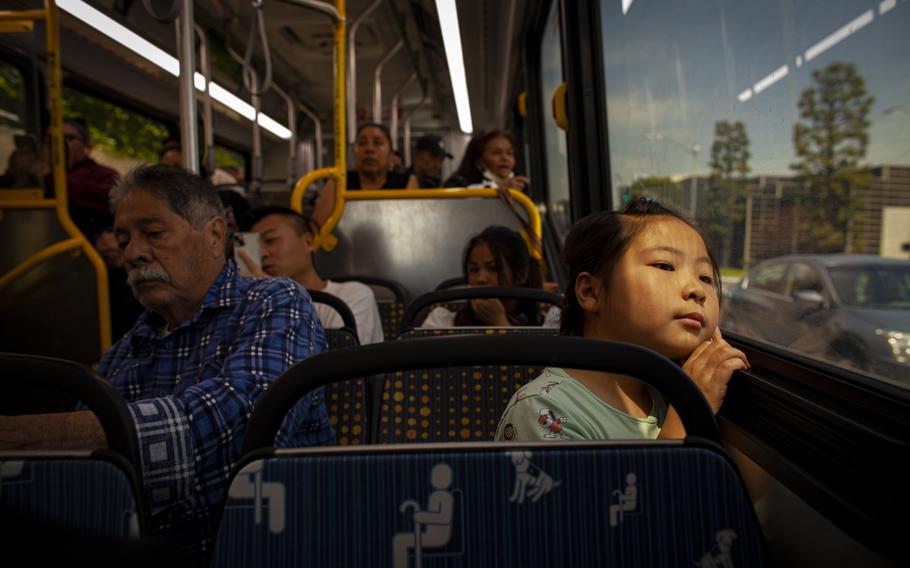
Lei Muhan, 10, peers out of a bus window in Los Angeles. (Li Qiang/The Washington Post)
LOS ANGELES - Lei Muhan and her parents crossed 11 nations along the journey from China to the United States, riding on the backs of motorcycles, paying off smugglers and trekking through a scorching desert.
The small California bedroom that now houses the family seemed a little dull by comparison. Muhan, 10, passed the time flipping through a spiral notebook, eager to start school. “I Am Happy,” she had written over and over in English.
Her father, Lei Xiaoyue, made rice for breakfast. If Muhan could enroll in school that morning, he could look for work.
The family arrived in the United States in April, joining the largest wave of illegal border crossings by Chinese immigrants in history - part of a wider influx that is also bringing record numbers of migrants from South America, India, Turkey and an array of African nations. Many are guided by global smuggling networks that seek to exploit the dysfunctional U.S. asylum system.
U.S. authorities have encountered more than 55,000 Chinese migrants crossing illegally from Mexico during the past 18 months, primarily in the rugged desert mountains east of San Diego - up from 3,813 in 2022. It is the last stage of the journey known in Chinese as zouxian - “walking the line.”
Driven in part by the stifling economic and political fallout of China’s extended covid-19 lockdowns, the Chinese arrivals have become a political and national security flash point in Washington. Leading Republicans, including former president Donald Trump, refer to the migrants as “fighting-age men,” and warn the influx could mask espionage activities, while Democrats, analysts and the migrants themselves point to China’s unemployment crisis and repressive government.
U.S. authorities worry about an even larger wave, given China’s population of 1.4 billion people and the difficulty of carrying out deportations. Officials say they detain any Chinese migrants who pose a public safety or national security threat, and the Biden administration is urging other Western Hemisphere nations to tighten controls.
The Washington Post spoke to almost three dozen recent Chinese migrants who had crossed the southern border, including families and lone travelers. They had settled in California, New York and elsewhere across the United States. They describe daily challenges divorced from geopolitics: consternation over their children’s future, struggles to find work in a saturated job market and fears of being scammed as they build new lives in America.
Many have arrived to the Flushing area of Queens, which has surpassed Los Angeles to become the top destination for the most recent Chinese migrants, according to a Post analysis of U.S. immigration court data. The neighborhood’s large Chinese-speaking community is a draw for new arrivals seeking jobs, housing and help with asylum claims.
Beijing denies its economy has influenced the migrants to go abroad, saying they are lured by human smugglers. Chinese President Xi Jinping and other Chinese authorities have appeared more and more determined to suppress the exodus, embarrassed by those willing to risk their lives and spend their savings to flee.
“Zouxian” information online is frequently censored. State-aired documentaries say migrants face mortal danger. Migrants and human rights advocates say Chinese customs officials screen the social media accounts of would-be travelers, refusing to let some depart regardless of whether their documents are in order.
“Even if you have a valid Chinese passport and a valid visa to Turkey or to Thailand or to Vietnam, you are not allowed to go abroad,” said New York-based immigration lawyer Xiang Xiaoji.
The Chinese Embassy in Washington said it has launched efforts to track down and repatriate those leaving China illegally.
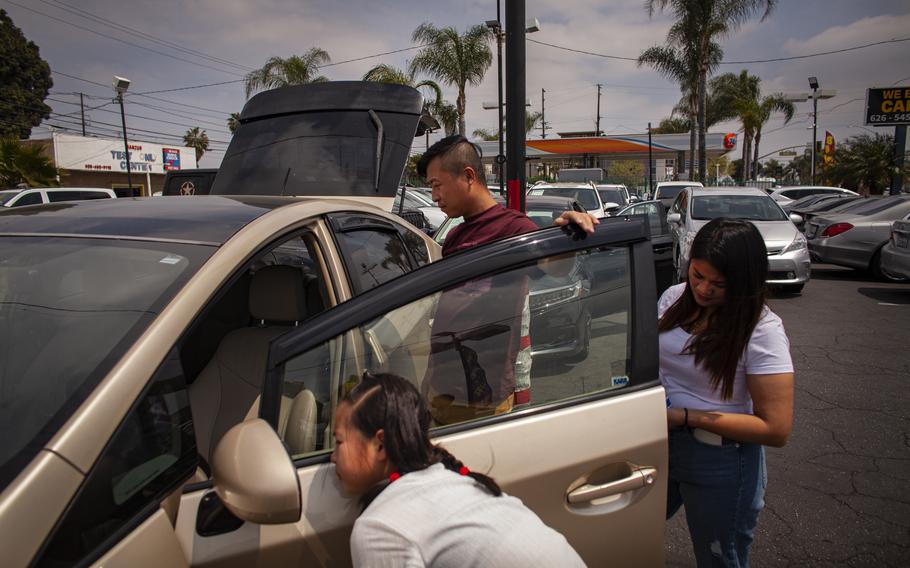
Lei and his family look at a secondhand car in an auto service shop. (Li Qiang/The Washington Post)
President Biden and Xi discussed immigration enforcement during a meeting in San Francisco last year, forging a new area of tentative cooperation at a time of otherwise deteriorating relations. The first U.S. deportation flight, in March, carried eight Chinese migrants; a second in June had 116 deportees.
Illegal entries - including by Chinese migrants - have dropped sharply since June 4, when Biden blocked access to the U.S. asylum system for most border-crossers. That change in policy is being challenged in federal court.
But amid a record number of crossings at the southern border over the last three years, China has been the largest source of illegal migration from any nation outside the Americas, according to Department of Homeland Security statistics.
Border Patrol agents line up migrants who crossed the U.S.-Mexico border near Jacumba Hot Springs, Calif., on April 15. The migrants are directed to a pickup area along the highway that functions as an outdoor arrival hall. A mother from Ecuador lifts a blanket to cover her 1-year-old son from the sun. The family crossed the border early that morning.
The influx has been a boon to criminal organizations in Mexico, which charge thousands of dollars to ferry customers from safe houses in Tijuana and Mexicali to remote crossings where migrants can skirt the U.S. border wall. Once on American soil, the Chinese migrants join others from around the world who surrender to U.S. agents and express a fear of persecution in their home nations, a first step in seeking asylum.
Those entering in the mountains outside San Diego are referred for interviews with Border Patrol agents trained to screen Chinese migrants for possible Communist Party and military ties. Their personal and passport information is matched to data collected by nations that share such details with the United States.
But Department of Homeland Security officials say additional information is rarely available, because cooperation with China is so limited.
Rep. Mark Green (R-Tenn.), chairman of the House Homeland Security Committee, said the screening process is inadequate given the potential threat of a coordinated operation by the Chinese government to infiltrate the United States with spies and operatives.
“Their agendas, their ideologies, and the reasons for coming here could substantially be missed,” said Green, who embraces his party’s hard line on the border and believes new arrivals from China should be detained longer and more thoroughly screened.
Migrants from China and other nations wait for Border Patrol vans to transport them from a makeshift camp to a San Diego detention center. The vans prioritize families with children, leaving some adults to wait for hours and keep warm with bonfires.
Mae Ngai, a Columbia University historian who has studied Chinese immigration to the United States, said the references by Republicans to “fighting-age men” are part of what she described as new forms of “China-mongering.”
“I think there’s this fascination with Chinese immigration, especially when it’s undocumented, that is disproportionate to its actual occurrence,” Ngai said. “And that has a very long history that’s associated with Chinese being seen as a special threat to the United States.”
Chinese migrants are dropped off by U.S. authorities at a transit center in San Diego in April. After calling relatives and friends, they depart for different states, with many headed first to Los Angeles.
Republican lawmakers say the concerns are more than justified. They point to media reports of at least 100 incidents in recent years in which Chinese nationals were caught or suspected of trying to gain access to or information about U.S. military installations.
U.S. immigration court data show about two-thirds of the migrants who have arrived from China during the past year are male, up from about 50 percent during previous years. Many of the men interviewed by The Post said they left their families behind because of warnings on social media about the dangers of the journey.
Migrants described fleeing stifling government control and economic malaise. Most recalled the strict coronavirus lockdowns as a turning point, with many losing their income and finding themselves in conflict with their country’s security apparatus.
When Lei Xiaoyue and his wife, Ye Qinqiong, decided to bring Muhan to the United States, they knew it would be the most perilous thing they ever did.
They guarded their plans tightly, including from relatives. Muhan was told only that they would be “traveling.” Lei prepared to never see his family in China again.
He bought a coffin and stashed it in his father’s house, worried he wouldn’t be able to return home to bury him. “I wanted to be able to take care of my dad’s affairs after I’m out,” he said.
Lei Xiaoyue carries his daughter Lei Muhan as the family explores downtown Los Angeles soon after crossing into the country in April. Lei stands on a bus after offering his seat to an elderly woman while en route to a U.S. Citizenship and Immigration Services office. Muhan and her parents pray for good luck at the Xilai Temple near their new home.
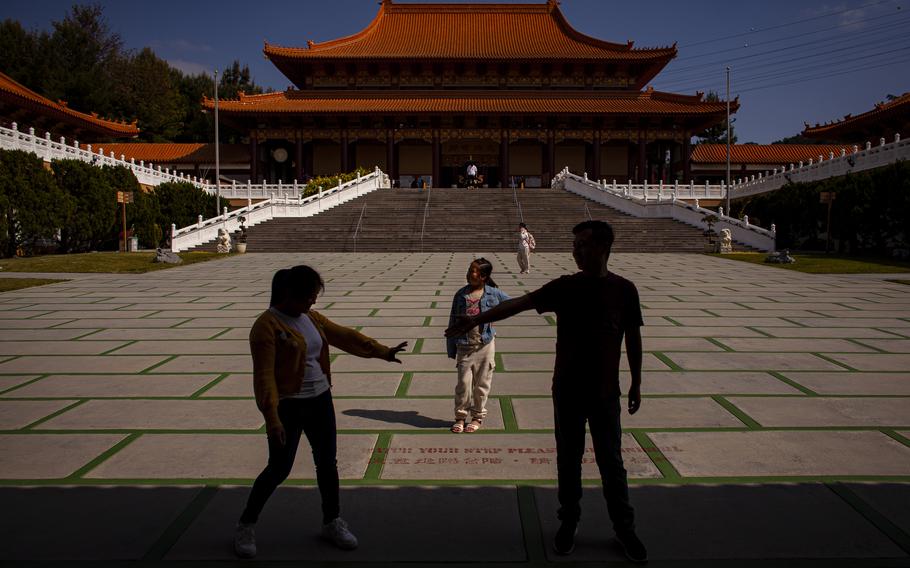
Lei Muhan and her parents visit Xilai Temple near their home in Los Angeles in May. The family arrived in the United States in April, joining the largest wave of illegal border crossings by Chinese migrants in history. The family’s motivation for coming to the United States was both economic and political. (Li Qiang/The Washington Post)
To be eligible for asylum, migrants have to show they faced religious, ethnic or political persecution in their homeland. Coming to the United States for better jobs and opportunities is not enough.
Yet those who reach U.S. soil can live and work in the country for years before getting a hearing in the backlogged immigration courts. If their asylum petitions are rejected, there is a lengthy appeal process. Migrants are typically eligible for U.S. work authorization after six months - a policy designed to help migrants support themselves financially while awaiting a court decision.
Lei and Ye said their motivation for coming to the United States was both economic and political. For years, the family endured what they described as a slow suffocation: Lei worked up to 16 hours a day as a taxi driver in Fujian province, 850 miles from their hometown; Ye, who moved there with him, sold clothes at a mall.
Like hundreds of millions across China, they were confined to their small neighborhoods or apartment complexes for long stretches during the pandemic. Lei said his family went hungry on the government-provided vegetable rations: “There just wasn’t enough to eat in a day.”
The Lei family tries hamburgers at an In-N-Out restaurant near their new home in Hacienda Heights. Muhan, who had seen videos of “American-style hamburgers” on Chinese TikTok, said she enjoyed her first meal out. She waits at a Chinese-speaking law office where her parents sought help applying for U.S. work permits in Monterey Park. The couple left their daughter behind with relatives, seeing her only during the Lunar New Year holiday.
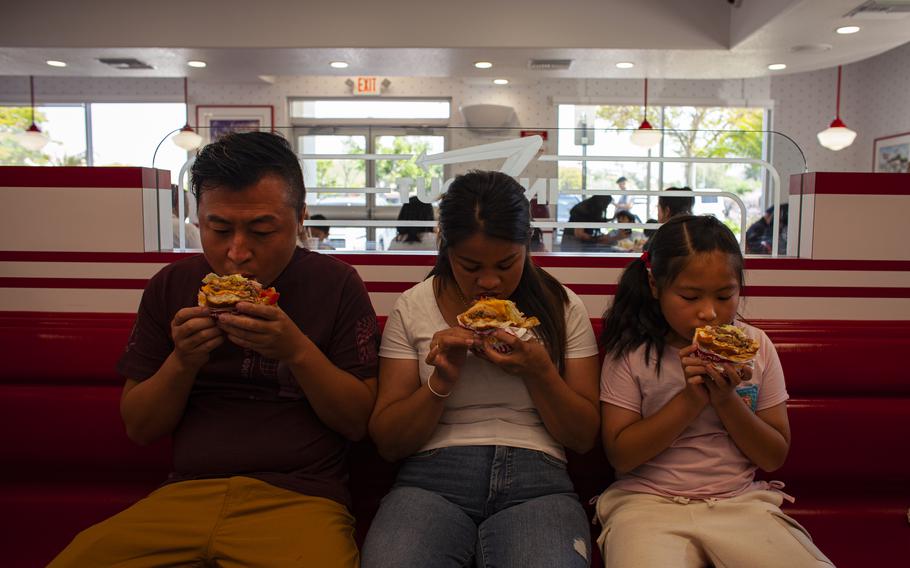
The Lei family tries hamburgers at an In-N-Out restaurant near their new home in Hacienda Heights. Muhan, who had seen videos of “American-style hamburgers” on Chinese TikTok, said she enjoyed her first meal out. (Li Qiang/The Washington Post)
But as lockdowns swept China - hurting the economy and generating a groundswell of public dissent - Lei and Ye brought their daughter to live with them, worried that otherwise they would never see her.
They grappled with how to educate her, because rural transplants to more prosperous areas are not allowed to enroll in public school. Then Muhan became sick.
After three days, her spiking fever drove Lei to sneak out of his home to find food and medicine. He said that’s when he was arrested and charged with obstructing the control of disease prevention - a violation for which, Lei said, he served a 15-day detention.
“The biggest thing that disgusted me is that my daughter was sick and had to go to the hospital during the pandemic, but we were not allowed to go,” he said. “The three years of the pandemic were so miserable for our family. I wanted to commit suicide, but thinking about [Muhan], I couldn’t do it.”
Instead he hatched a plan to walk the line.
The Lei family gets ready for bed at a hotel in Monterey Park. Their legs remain swollen and scabbed from insect bites after a two-month journey crossing 11 countries to reach the United States. Lei and Ye prepare dinner in an outdoor tent kitchen at the hotel.
Analysts say TikTok and other social media, and the availability of smuggling networks, have contributed to a shift in the demographics of those coming to the United States from China. Before, most relied on education, capital and connections. Now, people without those advantages can use VPNs to circumvent government censorship and learn how to make the trip.
Some recent arrivals in California showed The Post examples of PDF guides with step-by-step instructions for the trek from Ecuador to the U.S.-Mexico border, including the amount and color of Mexican pesos required for each bus trip.
“Remember it’s very dangerous to sit in the front of the (smuggler’s) boat, and people get thrown out a lot,” reads one guide on how to make a water crossing between Colombia and Panama to avoid border controls. Other Chinese migrants fly to Nicaragua, El Salvador or directly to Mexico, where they can get connecting flights to Mexican border cities.
The journey remains perilous. In March the bodies of eight Chinese migrants - seven of them women - washed ashore after their boat capsized off the coast of Mexico’s Oaxaca state, a popular migrant route. Authorities in Ecuador this month temporarily reimposed visa restrictions on Chinese travelers, hoping to keep migrants from using the South American nation as a springboard to the United States. Within days, however, Chinese-language videos on TikTok offered alternative, higher-priced routes with links to “travel agencies” that work with smuggling operations.
Those interviewed in California said they paid between $8,000 and $60,000 per person for the entire trip from China.
Smuggling groups take migrants to safe houses on the Mexican side, then pack a dozen or more into vehicles, including windowless cargo vans, for shuttle trips to drop-off points along the U.S. border. The groups then follow the dirt paths and jeep roads that lead to U.S. agents at a border crossing near Jacumba Hot Springs, Calif., a lunar landscape of odd-shaped boulders and cactuses called the Valley of the Moon.
That is where the Lei family entered the United States.
At the site one morning this spring, dozens of arrivals from around the world shivered in the wind and huddled near campfires that reeked of burning plastic.
About two dozen Chinese men stood apart, sharing stories of their months-long trek in the hands of smugglers. They showed off bug bites, bruises and - in one case - a swollen ankle with a bright red scar from a fall off a motorbike.
There were families from Colombia, young Kurdish professionals from Turkey and scattered Ecuadorians and Peruvians - a reminder that migrants from Latin American countries still outnumber those coming from China. A man who said he was part of a Chinese church group in San Diego arrived with a car battery and a web of power strips so migrants could charge their phones.
They waited for Border Patrol vans to take them to a San Diego tent facility for booking. If agents encounter “red flags,” such as links to the People’s Liberation Army or universities that feed into China’s military and intelligence agencies, migrants can be sent to a detention facility for more thorough screening and interviews.
“The info is only as good as the info in the database, and there is limited to nothing on many of these Chinese nationals,” said Chris Clem, who was chief of the Border Patrol’s Yuma Sector until retiring in December 2022.
The Lei family shops for a used vehicle at a lot catering to Chinese-speaking customers. Lei browses a beauty supply store in Monterey Park. In China, before driving a taxi, he worked as a hairdresser, and he hopes to find similar work in the United States. Muhan tries on clothing. Her family arrived with only a backpack.
Like many of the newly arrived migrants, the Lei family’s first days in America were a blur of living moment-to-moment. On their first day out of Customs and Border Protection detention - still dressed in gray and white U.S. government-issued clothes - the trio made their way in the Los Angeles area to Ding Pangzi Plaza in Monterey Park, where an aging strip mall has become a popular landing point.
Listings for dorm-style beds at $15 a night - including access to rice and cooking oil - cover the shop windows and power poles. Migrants who have been in the United States for months hunt for jobs, lawyers or help getting a driver’s license.
Ding Pangzi Plaza has also become a hotspot for scammers looking to take advantage of new arrivals, as the Lei family learned early on.
A landlord who rented them a place to sleep promised to let Lei drive under the landlord’s Uber driver account to make some money. Lei completed $900 in trips, but the landlord refused to pay him, and would not return their rental deposit when the family left.
The Lei family moved around different hotels and spent a long day shopping for clothes and a used car. The family naps while riding to a used car dealership. Father and daughter cook for the first time in her new home in Los Angeles. They pay $1,400 monthly for a bedroom and share the house with more than 10 tenants. The address allowed the Leis to enroll their daughter in school.
Another man, posing as a lawyer, promised to handle their asylum case for $2,000. They later discovered he was a fraud.
“They do these types of things to all the newcomers,” Lei said.
Perhaps the worst, the family said, was when Ye replied to a job posting she saw at the plaza.
It called for women with child-care experience willing to work about an hour outside the city. She arrived to find not babysitting work but a cannabis factory where she was expected to spend long hours in a refrigerated room clipping marijuana for around $100 a day. Workers got one day off a month. An agent took a fifth of the pay.
“Five or six women went there,” she said. “Each of us worked for a few days and left.”
Lei and Ye thought things would get better when Muhan started school, and they both had time to look for work, but even Muhan’s enrollment - the family’s top priority - did not go smoothly. The girl arrived for her first day, only to be turned back because her forms had not been processed.
“She has to go home,” Lei said that day, walking out the school doors with Muhan in tow. “Maybe tomorrow.” The Lei family shopping at an Ikea store after arriving in the United States.
Increases in Chinese immigration to the United States have historically followed major changes in Chinese and U.S. policy, including the upheaval of the 1989 Tiananmen crackdown and China’s 2001 admission to the World Trade Organization.
The most recent influx is characterized by small-business people and factory workers, said New York-based immigration lawyer Wei Zhu. “There are a lot of people wondering now what their future will be, so they say ‘Let’s go zouxian.’”
One draw for Flushing, attorneys say, is that immigration judges in New York City approve asylum claims at some of the highest rates in the country. And the neighborhood’s well-established Chinatown provides a soft landing. Yet the high cost of living and the long backlog in immigration cases mean crushing financial pressures, which have intensified as the flow of Chinese migrants creates fierce competition for informal jobs in construction and food delivery.
Day laborers gather early to look for work in the Flushing neighborhood of Queens, where many Chinese migrants have settled. That’s true for Joey - who came to the United States 18 months ago among the first wave of zouxian migrants and hopes to bring his two grade-school-aged children as well. He asked to be identified only by his adopted English nickname out of concern that his asylum case could be affected by his speaking candidly.
On a recent morning, he stood on a Flushing street with other Chinese migrants hoping for day labor, mostly cleanup and renovation jobs. He said the rate for a day’s work has fallen since he got here, from about $200 to $100 or $150, prompting some migrants to leave for other U.S. cities or return to China.
“Prices are constantly rising, but your salary is falling,” Joey said.
A van pulled up. Joey surged forward with the other men, but he wasn’t picked. Of the roughly 60 men on the street that morning, about 10 found work.
Newly arrived migrants say they continue to live under the watch of Chinese authorities, who often visit the relatives they left behind. About a month after Lei left China, his family frantically got in touch, telling him that the police had called.
“They said it was illegal and threatened my family. They told me to go back otherwise I would go to jail,” he said. Likely part of Beijing’s concern, analysts and lawyers say, is the potential for politicized Chinese migrants to become part of dissident communities abroad.
“The [Chinese] police told my parents, tell your son not to speak anymore or do any protests,” said Zhou Zheng, a recent migrant living in Los Angeles who joined groups that protested Xi’s November visit to San Francisco. He’d made the decision to walk the line after he was detained during protests in China.
The Flushing neighborhood in Queens is a top destination for new Chinese migrants. Message boards at local businesses advertise jobs, room rentals and immigration services.
While the number of Chinese migrants is relatively tiny in terms of the country’s population, its impact is significant for a government that has sought to advertise its political system abroad.
“It never looks good when people are willing to trek through the Darién Gap to get out of your country,” said Meredith Oyen, associate professor at the University of Maryland at Baltimore County, referring to the dangerous jungle crossing between Panama and Colombia.
For many of the migrants trying to get a foothold in the United States, the daily struggle - not Chinese politics - is the focus.
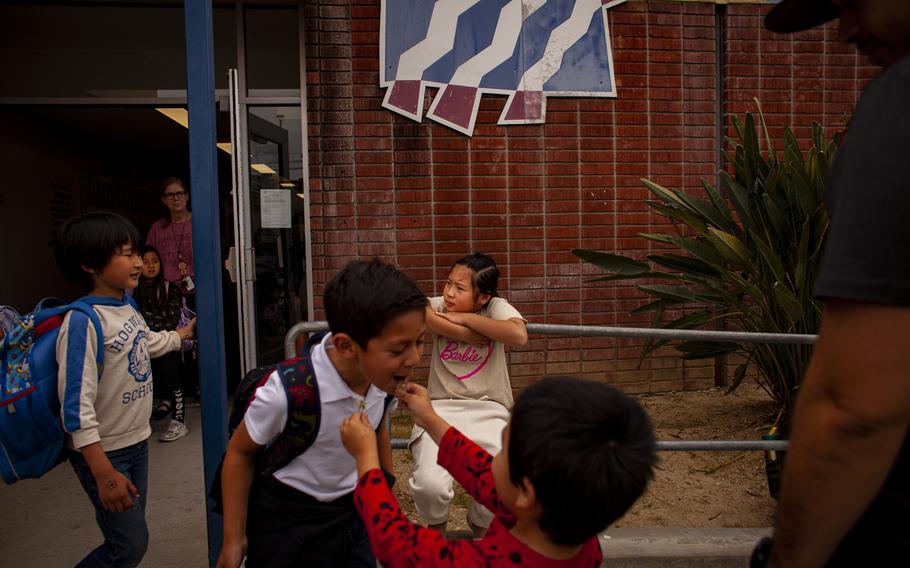
Muhan waits outside the school while her father attempts to register her. She was turned away on her first day of school because her forms had not been processed. Lei says he regrets what Muhan saw her parents go through, including their struggles once they reached the United States. “My child has suffered so much along the way. I think in her heart, it’s a perfect lesson,” he said. “She will know how terrible it can be for a person without education.” (Li Qiang/The Washington Post)
Days after Lei and Ye’s daughter Muhan was turned away from school in Monterey Park, she managed to enroll. Muhan practiced writing English phrases in a notebook. Muhan waits outside the school while her father attempts to register her.
Lei said his daughter made many friends, a stark difference after seeing few other children during the three-month journey to the U.S. border.
He said he regrets what Muhan saw her parents go through, including their struggles to find work in the United States.
“My child has suffered so much along the way. I think in her heart, it’s a perfect lesson,” he said. “She will know how terrible it can be for a person without education.”
“I just hope she studies hard and fits into this culture,” he said.